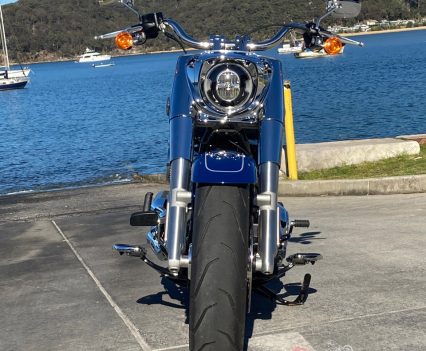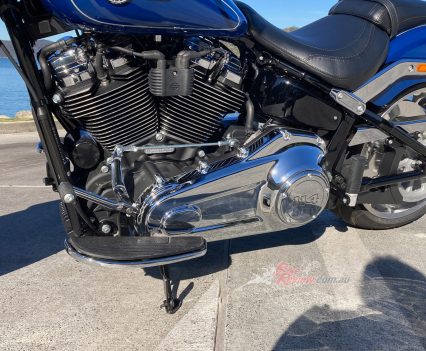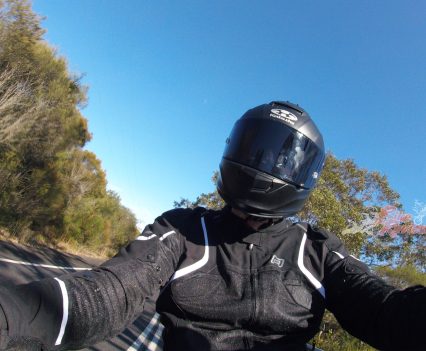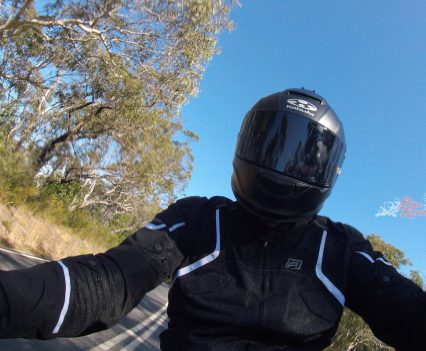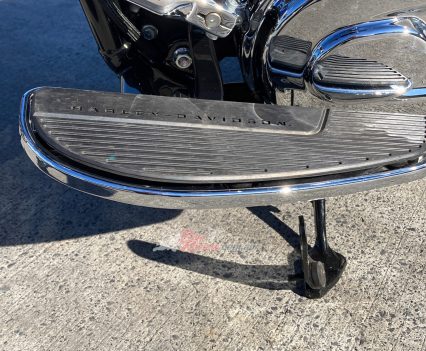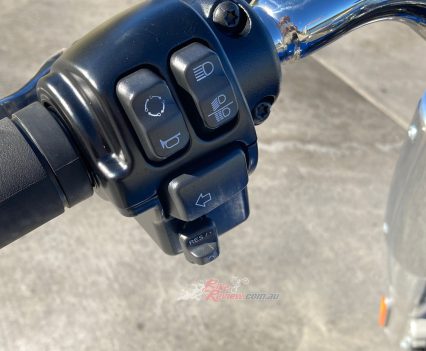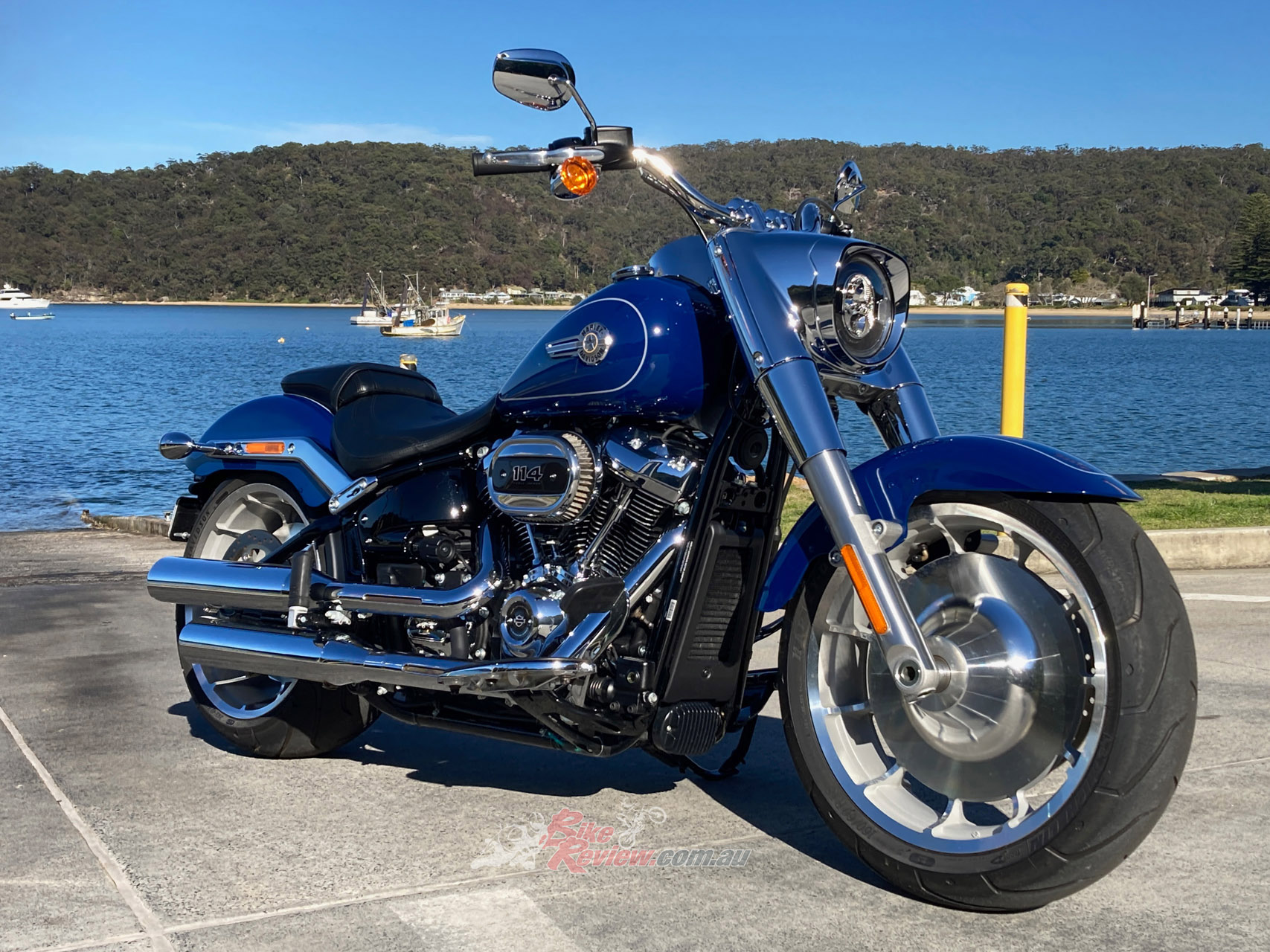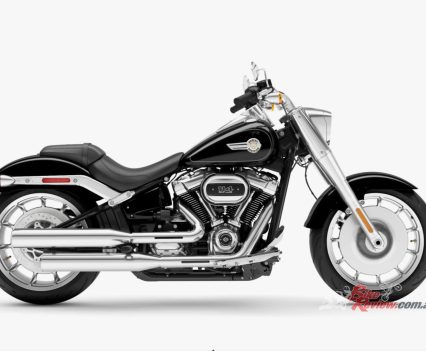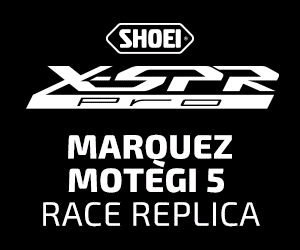Fat Boy Slim... Well, not in this case but the beats coming from the V-Twin 114 Milwaukee-Eight are enough to get you moving. Here is our Harley-Davidson FLSB Fat Boy test... Photos: JPMedia
Harley-Davidson’s Fat Boy is in its third generation now, having arrived almost 35-years ago powered by the 1340 Evo, then getting progressively bigger cubes as the Twin Cam engined versions came along from 2000, and now as we ride it, M8 114 powered…

Our 2023 test bike was Bright Billiard Blue, a colour not available in the 2024 lineup. Pricing remains $37,995 R/A
The first time I remember seeing a Harley-Davidson Fat Boy was at Village Twin Cinemas, where I went to watch Terminator 2, Judgment Day when I was 16. I still had a few years left of school, and was yet to get my riding licence, not quite being 16 and 9 months when the movie came out at the start of summer 1991. At the time, I already had a 1985 RZ250 I was doing up in readiness for my L plates, but for a while there, I started to get more interested in the Fat Boy than the two-stroke racer replica…
That Fat Boy became so iconic, and seemed to be in every poster and TV ad for the movie, around every corner or on every TV, in every magazine, for months… For some reason, Arnie on the big H-D were just a match made in heaven, and the thought of cruising around on a Fat Boy was pretty appealing to a young impressionable rev head. At 60kg wringing wet then, I doubt I’d have been able to pick one up off the side-stand, let along ride one. Of course, I didn’t have a dollar to my name after spending it all ($1500 AUD) on buying the wrecked and blown up RZ. It was all a pipe dream…

The Harley-Davidson Fat Boy is one of the most iconic, if not the most iconic, Harley models, partly thanks to its Hollywood stardom! Wide 18in wheels and tyres front and back, fat forks and ‘bars make it unique.
As years went by, and even a period when I was full time staff at Live To Ride mag in the early 2000s, riding a Fat Boy eluded me… and of all the Harley models I want to ride, the Fat Boy has always been high on the list thanks to that movie back in my HSC days. So, when I got the call from H-D ANZ to ask if I wanted to review the 2023 model, I could not get down to Sydney to H-D head office to pick it up fast enough… I was on the train, in an Uber and then on the Fat Boy in no time…
THE RIDE
I put my Arnie face on and head on up the highway, without the muscles, money, and, well, in a full face helmet. Still, I’m feeling it as I drag race mums doing the school pickup from light to light in busy North Ryde. In Bright Billiard Blue, this Fat Boy is all chrome and shiny happy sort of looking, not the tough look I was hoping for, but it still feels good to finally have my ass planted on a bike I’ve wanted to ride for over 30-years. The 120th Anniversary models were all sold out, I would have liked a spin on one.

Corners aren’t the natural territory for the Fat Boy to venture, but so long as you take it slow in the curves, the bike is still fun to ride. The wide handlebars and great ergonomics help to manhandle the Fat Boy through the twisties.
The 114 M8 is offering plenty of torque off the line, with the chunky clutch lever heavy, but giving a smooth and progressive take-up. Shifting is a slow job, no rushing, nothing new for a big twin, but the lever is well positioned on the footboard. Fuelling is smooth and the throttle not at all snatchy from closed, while the exhaust note is strangled and just way too quiet. We all know how to fix that…
There’s not much of an intake growl as I stretch the throttle cable, but short-shifting and opening up the M8, riding that broad torque curve, does deepen the note enough to get me grinning. It’s a fun ride… Not super quick, but more than enough to leave the traffic for dead, and make me smile…
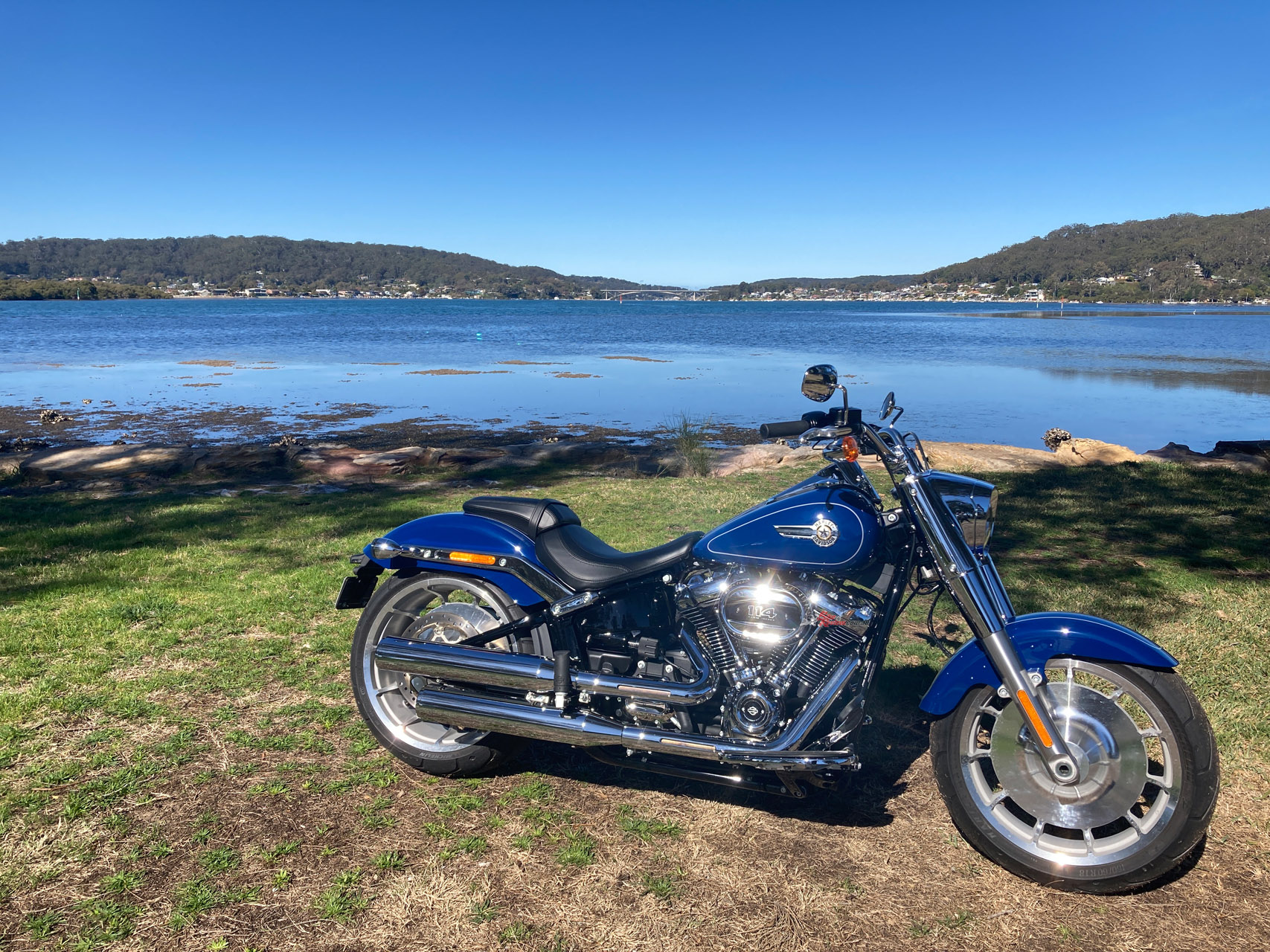
“It makes sense that Harley dropped the 107 option a few years ago and only have the 114 version these days…”
I’m a fan of the 114 M8, although the baby 107 is my favourite for smooth cruising, the little bit of extra grunt the 114 has (7kW and 10Nm more), makes the little bit of difference needed for a bit of grunt when overtaking, or off the lights, so it makes sense that Harley dropped the 107 option a few years ago and only have the Fat Boy in the 114 version these days…
The 114 literally ticks along at 110km/h, nice and smoothly, with enough grunt on tap to pass or climb the hills effortlessly…
As I negotiate the last of the traffic, I’m impressed with the rear brake of the Fat Boy. Lots of power, nice feel and it does a good job stopping the 317kg beast. I hardly need the front brake in this situation, but it’s also not bad and using both together, the Fat Boy actually pulls up well. But like I always say, another front disc could never hurt…
Flicking through a series of roundabouts, I realise pretty quickly that there seems to be some type of alignment issue or balance issue going on. I stop at a servo and check the tyre pressures. All seems OK, so I head off, joining the motorway for a 40km top gear cruise towards home. The 114 literally ticks along at 110km/h, nice and smoothly, with enough grunt on tap to pass or climb the hills effortlessly.
The riding position is comfortable. I’m 187cm and fit the Fat Boy well. Enough legroom (although I’d like bigger platforms so I could change feet position occasionally), a comfy and generous enough seat (good for 1.5hrs for me), and the reach to the wide ‘bars is good. Of course, I’m a windsock up in the breeze, but that’s all part of the ride on a cruiser or nakedbike. The switchgear is all easy to use and standard H-D stuff, the tank mounted dash need a look down but the big speedo needle helps.

“Slowing right down to the recommended speed for the corners, the Fat Boy settles and is just a pleasant cruise.”
Hitting the twisties, I don’t have high expectations for the Fat Boy, so I’m not too surprised when I find myself having to wrestle it through the hills. It has very little ground clearance (my boots touch the road before the platforms), bump steers off line thanks to the massive rear tyre, and seems to like left handers more than right handers. Slowing right down to the recommended speed for the corners, the Fat Boy settles and is just a pleasant cruise (the Fat Boy comes standard with cruise control).
With such wide front and rear tyres, the unique handling in corners is just something owners should expect and accept, and stick to straight line cruising or more gentle cornering. The ride is still enjoyable when done within the bike’s limitations, but wide tyres are always a massive compromise. The upside is stable straight line motorway cruising. The Fat Boy is rock solid out on the open road, and the front and rear suspension supportive enough to cope with the weight, while still giving some level of comfort.

Running a massive 240-section 18in back tyre and a 160-section front, cornering is second to looks on a bike like this.
It’s a cruiser, and just needs to be treated as such, but even the slightest push sees it turn into a difficult motorcycle to ride. Later at BR HQ, when I am washing the bike, I notice the wheel offsets, common for the solid wide wheel H-D models, but seemingly way more pronounced on the Fat Boy. Problem identified… No wonder the bike leans a little in a straight line too. Both wheels are off centre to the centre of the motorcycle…
Harley do this to counter balance the heavy primary drive side and accomodate the wider rim and offset centre-hub of the rear wheel. An “interesting” fix indeed. Most M8 powered Harley’s would have some amount of offset built into them to accomodate the engine shape and weight, but the amount of offset on the Fat Boy seems excessive and it looks odd too, particularly the small gap on one side and large gap on the other side between the front guard and tyre. At first glance it looks like someone has left a wheel spacer out. I can’t believe the front and rear guards aren’t adjusted to match the tyres!
Over the next fortnight I use the Fat Boy as my daily rider, whether commuting to my office in town for BikeReview duties, to the shops for (mainly) a beer or wine run, or visiting people and going to meetings. I soon become very used to the bike, the weight and balance and by the time I drop it back to H-D, I’m riding around the balance and handling mannerisms, and enjoying all of the positive things about the Fat Boy, such as the comfort, the smooth engine, the rear brake and the looks… The only thing I wasn’t able to test was pillion riding, as the Pillion In A Million was too busy to come for a spin.
As I rode into the dock at Harley to return the bike and, while there, check out the Fast Johnnie range, I quietly tapped the Fat Boy on the tank, telling it that without a doubt, “I’ll be back”!
Fat Boy Tech Talk
The Milwaukee Eight has been the heart for many Harley-Davidson models for years now, and it’s still an awesome engine. The 109ci was dropped from the Fat Boy lineup from 2020, leaving the 114 to do duties. Retaining the classic 45-degree V-Twin cylinder angle, the Milwaukee-Eight engine produces 10 per cent more torque (varies per model) than previous year models and features four-valve cylinder heads that offer 50 per cent more intake and exhaust flow capacity. The Fat Boy motor makes 69kW[93hp]@5020rpm and 155Nm of torque@3000rpm. Claimed fuel consumption is 5.5L/100km, over our test we got an average of 6.3L/100km.
The Milwaukee-Eight engine is counter-balanced to cancel 75 per cent of primary vibration at idle, retaining the classic feel of a Harley V-Twin while being very smooth at highway speeds. A new heat management strategy for all Milwaukee-Eight engines improves rider and passenger comfort.
Four-valve cylinder heads (two exhaust and two intake valves per head, eight total) promote airflow through the engine and contribute to power output, and dual spark plugs ensure more complete combustion to maximise power and efficiency. Advanced cylinder head design, dual knock sensors, and precision cooling allow a 10.5:1 compression ratio for strong torque output and acceleration, while a single camshaft helps reduce mechanical noise so a richer exhaust tone can predominate.
The mild steel tubular chassis is based from the Softail platform and has SHOWA front and rear suspension. The forks are SDBV forks (SHOWA Dual Bending Valve), which run two sets of valving for compression and rebound, while at the back the SHOWA monoshock is mounted under the seat and has remote preload adjustment. Back in 2022 the Fat Boy got some small upgrades, like the Lakester wheels being restyled, with turbine-like spokes and hollow centres, and small cosmetic changes.
2024 Fat Boy Colours
Harley-Davidson Fat Boy FLFBS Specifications
Price: From $37,995 Ride-Away (2024)
Warranty: two-years unlimited km
Colours: Billiard Gray, Vivid Black (+$280), Red Rock (+$370), Sharkskin Blue (+$430)
Claimed Power: 69kW@5020rpm
Claimed Torque: 155Nm3000rpm
Wet Weight: 317kg
Fuel capacity: 18.9L
Engine: Air-cooled Milwaukee-Eight 114 V-Twin, 1868cc (114 cu. in.), 102 x 114mm bore x stroke, 10.5:1 compression ratio, two-into-two exhaust
Gearbox: Primary drive: 34/46. Six-speed ratios – 1st: 9.311, 6.454, 4.793, 3.882, 3.307 6th: 2.79 Final Belt 34/46 Clutch: Wet multi-plate, cable actuation
Chassis: Mild steel tubular frame
Rake: 30° Trail: 132mm
Suspension: Dual-bending valve SHOWA 49mm telescopic with aluminum fork triple clamps; dual rate spring; “beer can” covers (f) Hidden, SHOWA free piston, coil-over monoshock; 43mm stroke; toolless hydraulic preload adjustment (r)
Brakes: Front and rear black, Split 7-spoke floating rotors four-piston fixed front and two-piston floating rear, ABS
Wheels & Tyres: Machined, Lakester cast aluminum, 160/60-18in (f), 240/40B-18in (r), Michelin Scorcher 11
DIMENSIONS
Wheelbase: 1665mm
Seat height: 675mm
Ground clearance: 115mm
Overall Length: 2370mm
Instruments & Electrics: 5-inch analog speedometer with digital gear, odometer, fuel level, clock, trip, range and tachometer indication, All LED headlamp, low and high beam with signature position lighting; Integrated, multi-function LED stop/tail/turn signals; Incandescent bullet turn signals; Integrated, multi-function LED stop/tail/turn signals
Editor’s Note: If you are reading this article on any website other than BikeReview.com.au, please report it to BikeReview via our contact page, as it has been stolen or re-published without authority.
Ratings | Fat Boy Review | Harley-Davidson FLFBS Test, 2023
Solid!
The Harley-Davidson Fat Boy is one of the most popular bikes in the H-D linep and has been for decades, but we found the bike is more about styling than practicality in many ways. We put it to the test fairly and here are our results…





